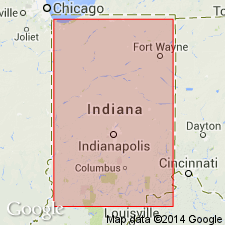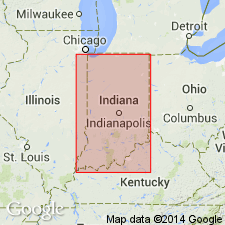
- Usage in publication:
-
- Butlerville Till Member
- Modifications:
-
- Named
- Dominant lithology:
-
- Till
- Mudstone
- AAPG geologic province:
-
- Cincinnati arch
Summary:
Butlerville Till Member of Jessup Formation named in Jennings Co., southeastern IN. Consists dominantly of conglomeratic mudstone with lenses of gravel, sand, silt, and clay, and a few lenses of peat and marl. Consists of at least two and possibly three units of till that are separated by fossiliferous silt beds. Distinctive weathered zone, buried where member is overlain by younger sediments, caps Butlerville and serves as key bed for recognizing top of Jessup. Thickness about 27 ft at type section. Overlies Cloverdale Till Member (new).
Source: GNU records (USGS DDS-6; Reston GNULEX).

- Usage in publication:
-
- Butlerville Till Member(?)
- Modifications:
-
- Areal extent
- AAPG geologic province:
-
- Illinois basin
Summary:
Butlerville Till Member of Jessup Formation is tentatively extended into the Wabash Valley of west-central IN where it overlies Smithboro Till Member of Glasford Formation and underlies Center Grove Till Member of Trafalgar Formation. Age is Pleistocene.
Source: GNU records (USGS DDS-6; Reston GNULEX).
For more information, please contact Nancy Stamm, Geologic Names Committee Secretary.
Asterisk (*) indicates published by U.S. Geological Survey authors.
"No current usage" (†) implies that a name has been abandoned or has fallen into disuse. Former usage and, if known, replacement name given in parentheses ( ).
Slash (/) indicates name conflicts with nomenclatural guidelines (CSN, 1933; ACSN, 1961, 1970; NACSN, 1983, 2005, 2021). May be explained within brackets ([ ]).

